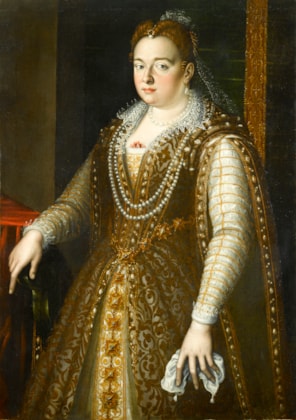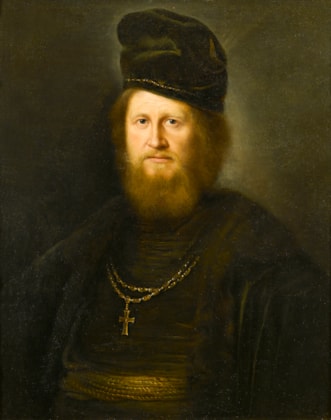ionijs Verburgh
(Rotterdam c.1655 - 1722)
A Town in a Hilly Landscape with a River and Several Figures
signed with monogram 'Dvb' (lower left)
oil on panel
70 x 86 cm. (27½ x 33⅞ in)
Dionijs Verburgh possessed a distinctive individual style that is particularly noteworthy in his landscapes. This scene is typical of his panoramas, which are often seen from a high viewpoint and always contain a plethora of landscape elements. Invariably, towns inhabited with tiny figures are situated by riverbanks and nestled between peaked mountains, as exemplified in his A River Landscape with Figures Outside an Inn Beneath a Ruined Castle, a Town Beyond (Private Collection). They are imbued with a peaceful, poetic atmosphere, which in the present work is achieved by the subtle tones, stippled foliage, calming influence of the church and quiet activities of the townsfolk.
Closer inspection of the painting reveals a masterly and charming attention to detail, from the swans on the lake to the clock on the church tower. The figures that fill his paintings demonstrate the skill of his brushwork as well as his playful imagination. In this painting, a man fishes, another takes off his hat to greet two ladies, a boy plays with a dog and a woman leans out of her door to bellow commands at her husband.
The expression of spaciousness and atmosphere through subdued colour, which Verburgh achieves here, were popular Dutch techniques in the seventeenth century. Taking in the painting as a whole, the composition is a celebration of the countryside, which stems from a tradition of Dutch painting which looked to landscapes, townscapes and marine scenes as a means of expressing pride in their country. Such a desire developed from the long struggle for independence from Spain, which was finally achieved in 1648 with the Peace of Münster. This was a significant cornerstone in Dutch history and was to condition and influence the nature of Dutch art in the seventeenth century.
Consequently, landscape views which served to celebrate their nationhood were often favoured over religious, mythological and historical works - themes which were a common tradition amongst their European counterparts. The reverence for nature and expression of heroic spirit in the works of Dutch landscape painters ensured their enduring popularity and significant influence on later art, most notably in England.
A landscape painter from Rotterdam, Verburgh was a follower of Gerrit van Battem (c. 1636-1684). Notable for painting some of the figures in van Ruisdael’s famous landscapes, in his personal work van Battem specialised in imaginary landscapes, painting mountain scenery, towns, winter views and woodlands. His preference for incorporating figures within a panoramic backdrop of mountains, rivers and woodlands shows the influence he exerted on Verburgh.
A Town in a Hilly Landscape therefore reveals the influence of two notable Dutch painters on Verburgh’s landscapes as well as his continuation of the nation’s unrivalled embracement of genre painting. An artist who was to be recognised in his own right for his superior portrayal of landscape scenes, he in turn attracted his own circle of followers.
Mrs. Booth Greys;
by whom passed to Mrs Charlton Parr (according to a label on the reverse);
Archibald Werner;
by whom sold, Christie's, London, 25 July 1958, lot 64 (as Samuel van Hoogstraten)
sale, Sotheby's London, 24 July 1974, lot 64 (as Samuel van Hoogstraten) ;
where purchased by Agnew's;
Major H. F. B. Foster;
sold by his executors, Christie's, London, Old Master Pictures, 31 October 1997, lot 15;
sale, Hampel Kunstauktionen, Munich, 20 September 2003, lot 1732;
where purchased by the previous private collector.
Dionijs Verburgh possessed a distinctive individual style that is particularly noteworthy in his landscapes. This scene is typical of his panoramas, which are often seen from a high viewpoint and always contain a plethora of landscape elements. Invariably, towns inhabited with tiny figures are situated by riverbanks and nestled between peaked mountains, as exemplified in his A River Landscape with Figures Outside an Inn Beneath a Ruined Castle, a Town Beyond (Private Collection). They are imbued with a peaceful, poetic atmosphere, which in the present work is achieved by the subtle tones, stippled foliage, calming influence of the church and quiet activities of the townsfolk.
Closer inspection of the painting reveals a masterly and charming attention to detail, from the swans on the lake to the clock on the church tower. The figures that fill his paintings demonstrate the skill of his brushwork as well as his playful imagination. In this painting, a man fishes, another takes off his hat to greet two ladies, a boy plays with a dog and a woman leans out of her door to bellow commands at her husband.
The expression of spaciousness and atmosphere through subdued colour, which Verburgh achieves here, were popular Dutch techniques in the seventeenth century. Taking in the painting as a whole, the composition is a celebration of the countryside, which stems from a tradition of Dutch painting which looked to landscapes, townscapes and marine scenes as a means of expressing pride in their country. Such a desire developed from the long struggle for independence from Spain, which was finally achieved in 1648 with the Peace of Münster. This was a significant cornerstone in Dutch history and was to condition and influence the nature of Dutch art in the seventeenth century.
Consequently, landscape views which served to celebrate their nationhood were often favoured over religious, mythological and historical works - themes which were a common tradition amongst their European counterparts. The reverence for nature and expression of heroic spirit in the works of Dutch landscape painters ensured their enduring popularity and significant influence on later art, most notably in England.
A landscape painter from Rotterdam, Verburgh was a follower of Gerrit van Battem (c. 1636-1684). Notable for painting some of the figures in van Ruisdael’s famous landscapes, in his personal work van Battem specialised in imaginary landscapes, painting mountain scenery, towns, winter views and woodlands. His preference for incorporating figures within a panoramic backdrop of mountains, rivers and woodlands shows the influence he exerted on Verburgh.
A Town in a Hilly Landscape therefore reveals the influence of two notable Dutch painters on Verburgh’s landscapes as well as his continuation of the nation’s unrivalled embracement of genre painting. An artist who was to be recognised in his own right for his superior portrayal of landscape scenes, he in turn attracted his own circle of followers.
Mrs. Booth Greys;
by whom passed to Mrs Charlton Parr (according to a label on the reverse);
Archibald Werner;
by whom sold, Christie's, London, 25 July 1958, lot 64 (as Samuel van Hoogstraten)
sale, Sotheby's London, 24 July 1974, lot 64 (as Samuel van Hoogstraten) ;
where purchased by Agnew's;
Major H. F. B. Foster;
sold by his executors, Christie's, London, Old Master Pictures, 31 October 1997, lot 15;
sale, Hampel Kunstauktionen, Munich, 20 September 2003, lot 1732;
where purchased by the previous private collector.





 contact
contact contact
contact +44 20 7313 8040
+44 20 7313 8040









